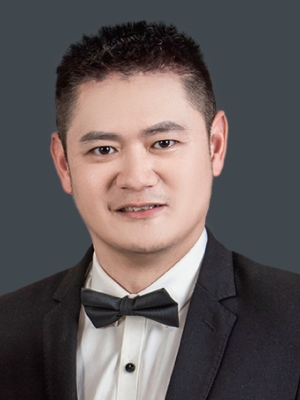教育背景
2004.09-2008.06,南京大学,物理学院,理学学士学位。
2008.08-2014.12,美国佛罗里达大学,物理系,理学博士学位。
工作履历
2015.01-2017.06,美国佛罗里达大学物理系和量子理论中心,博士后。
2017.07-2020.07,美国加州大学圣地亚哥分校纳米工程系, 博士后。
2020.08-2021.07,美国威斯康星大学麦迪逊分校材料科学工程,助理科学家。
2021.08-至今,威廉希尔WilliamHill官方网站料学院,副教授,硕士生导师。
学术兼职
npj Computational Materials 客座编辑; Physical Review Letter,npj Computational Materials,Journal of Materials Chemistry C, Physical Review B, Physical Review Materials, Physical Review Research等SCI期刊评审专家;
主讲课程
本科生:AI辅助材料设计;大学物理
研究生:材料设计与计算材料学
科研工作
【学术表现】
长期基于对尺度模拟结合人工智能对新材料、材料物性及其内在性能机理展开系 统研究,至今取得了一系列国际领先的原创性研究成果。在低维材料物性方面,系统研究了一系列单分子磁体的磁性机制,发现了一种新的基于f轨道的磁直接相互作用。此外在方法上发展了一种新的基于多重散射理论的电子传输方法,并用之系统研究了基于石墨烯的新型场效应管的电子传输问题;在人工智能辅助设计材料方面,通过高通量计算建立了基于第一性原理计算的目前最大最广的金属晶界能数据库,并在著名数据库中心Materials Project发布。同时也是从事机器学习势函数这一新兴领域最早的学者之一,为机器学习势场推广到多元合金体系作出了重要的贡献。此外发展了一种基于原子结构图形化的预测材料禁带宽度的深度学习模型。此部分的研究得到了领域同行的广泛关注,多次受邀参加高水平国际会 议做邀请报告。至今发表学术论文60余篇,其中以第一/通讯作者身份在Nat. Commun.、Nano Lett.、npj Comput. Mater. 、Acta Mater.、Phys. Rev. B等高水平期刊发表研究论文18篇,累计引用3400余次。受邀担任 Nature 旗下计算 材料顶刊 npj Comput. Mater.客座编辑,已评审或仲裁物理顶刊 Phys. Rev. Lett.论文 15 篇以及其他材料和物理期刊Adv. Funct. Mater., npj Comput. Mater.等总计 60 余篇。回国以后一直担任深圳市科创委通讯评审专家。
欢迎对结合人工智能和多尺度模拟研究材料性质有兴趣的学生联系报考研究生(未来走学术道路或是进工业界均可)。
研究领域
(1)多尺度模拟结合人工智能设计低维磁性材料
(2)基于机器学习势函数分子动力学模拟的高熵合金设计
(3)低维材料电子结构、磁性等性能的第一性原理计
研究方法
1)第一性原理 2)分子动力学 3)机器学习 4)高通量计算 5)量子输运
计算机语言
1)Python 2)Fortran 3)Bash
【主要文章】
1. Wang T, Li J, Wang M, Li Cheng, Su Y, Xu S, Xiang-Guo Li* (李相国), Unraveling dislocation-based strengthening in refractory multi-principal element alloys, npj Computational Materials, 2024, 10(1), 143.
2. Wang M, Li C, Xiang-Guo Li*, Hou Yanglong “Direct observation of strong t2g-eg orbital hybridization and effects of orbitals in a molecular analogue of chromium perovskite”, Physical Review B, 2024, 110, L020409.
3. Huang X, Li C, Yuan M, Shuai J, Xiang-Guo Li*, Hou Yanglong, “Unphysical grain size dependence of lattice thermal conductivity in Mg3 (Sb, Bi)2: An atomistic view of concentration dependent segregation effects ”, Materials Today Physics, 2024, 43, 101386.
4. Wang M, Wang T, Yuan M, Zhang Q, Liu S, Shuai J, Xiang-Guo Li*, “Molecular analog of perovskite ferrites: First-principles studies of electronic and magnetic
properties”, Physial Review B, 2023, 108(18): 184421.
5. Ouyang P, Yuan M, Tang P, Zhang Q, Liu S, Shuai J, Xiang-Guo Li*, “Atomic Local Ordering and Alloying Effects on the Mg3(Sb1–xBix)2 Thermoelectric Material”, ACS Applied Materials & Interfaces, 2023, 15: 37554.
6. Xiang-Guo Li*, Xu S, Zhang Q, Liu S, Shuai J, “Complex strengthening mechanisms in nanocrystalline Ni-Mo alloys revealed by a machine-learning interatomic potential”, Journal of Alloys and Compounds, 2023, 952, 169964.
7. Xiang-Guo Li, Blaiszik B, Schwarting M E, Jacobs R, Scourtas A, Schmidt KJ, Voyles PM, Morgan D. Graph network based deep learning of bandgaps. The Journal of Chemical Physics, 2021, 155(15), 154702
8. Xiang-Guo Li, Chi Chen, Hui Zheng and Shyue Ping Ong, “Complex Strengthening Mechanisms in the NbMoTaW Multi-Principal Element Alloy”, Npj Computational Materials 6, 1, 2020.
9. Hui Zheng#, Xiang-Guo Li#, Richard Tran, Chi Chen, Matthew Horton, Donny Winston, Kristin A. Persson and Shyue Ping Ong, “Grain Boundary Properties of Elemental Metals”, Acta Materialia 186, 40, 2020.
10. Annaliese. Thuijs#, Xiang-Guo Li#, Yun-Peng Wang, Khalil A. Abboud, X. -G Zhang, G. Christou and Hai-Ping Cheng, “Molecular Analogue of the Perovskite Repeating Unit and Evidence for a Direct MnIII-CeIV-MnIII Exchange Coupling Pathway”, Nature Communication 8, 500, 2017.
11. Xiang-Guo Li, X. -G Zhang and Hai-Ping Cheng, “Conformational Electroresistance and Hysteresis in Nanoclusters”, Nano Lett, 14, 4476, 2014.
12. Xiang-Guo Li, Chongze Hu, Chi Chen, Zhi Deng and Shyue Ping Ong, “Quantum-Accurate Spectral Neighbor Analysis Potential Models for Ni-Mo Binary Alloys and FCC Metals”, Phys Rev. B 98, 094104, 2018.
13. Xiang-Guo Li, I. H. Chu, X. -G Zhang and Hai-Ping Cheng, “Electron transport in graphene/graphene side-contact junction by plane-wave multiple-scattering method”, Phys, Rev. B 91, 195442, 2015.
14. Xiang-Guo Li, James N. Fry and Hai-Ping Cheng, “Single-molecule magnet Mn12 on graphene”, Phys, Rev. B 90, 125447, 2014.
15. Xiang-Guo Li, Yun-Peng Wang, X. -G Zhang and Hai-Ping Cheng, “Tunneling field-effect junctions with WS2 barrier”, Journal of Physics and Chemistry of Solids 128, 343, 2019.
【科研课题】
- 广东省自然科学基金面上项目,2025-2027
- 中山大学百人计划启动经费,2021-2024 (主持)
- 美国海军办公室研究基金-多主元素合金:探索、设计和理解 (科研骨干)
- 美国科学基金-探索多功能分子电子结构材料 (科研骨干)
【学术会议报告】
- 特邀报告:“Quantum-accurate force fields from machine learning of large materials data”, LAMMPS Workshop and Symposium, Albuquerque, NM, USA. ( Aug, 2019)
- 特邀报告:“Quantum-accurate force fields from machine learning of large materials data”, Machine Learning and Informatics for Chemistry and Materials Workshop, Telluride, CO, USA. (Oct, 2018)
- 邀请报告:“First-principles simulations of Graphene/Transition-metal-Dichalcogenides/Graphene Field-Effect Transistor”, Sanibel Symposium, St. Simons Island, GA, USA. (Feb, 2017)
- 邀请报告:“First-principles simulations of Graphene/WS2/Graphene Field-Effect Transistor”, APS March Meeting, Baltimore, MD, USA. (Mar, 2016)
- 邀请报告:“First-principles study of a single-molecule magnet Mn12 monolayer on the graphene surface”, APS March Meeting, Denver, CO, USA. (Mar, 2014)
- 邀请报告:“First-principles study of charge transfer doping and electronic transport in single-walled carbon nanotubes”, APS March Meeting, Boston, MA, USA. (Mar, 2012)
- 邀请报告:“Electronic properties of Si-C interfaces”, APS March Meeting, Dallas, TX, USA. (Mar, 2011)
奖励与荣誉
- 广东省重大人才工程青年拔尖人才(2024)
- 深圳市“鹏城孔雀”高层次人才 (2022)
- 美国佛罗里达大学CCMS奖学金(2009)
- 南京大学国家奖学金(2005)

